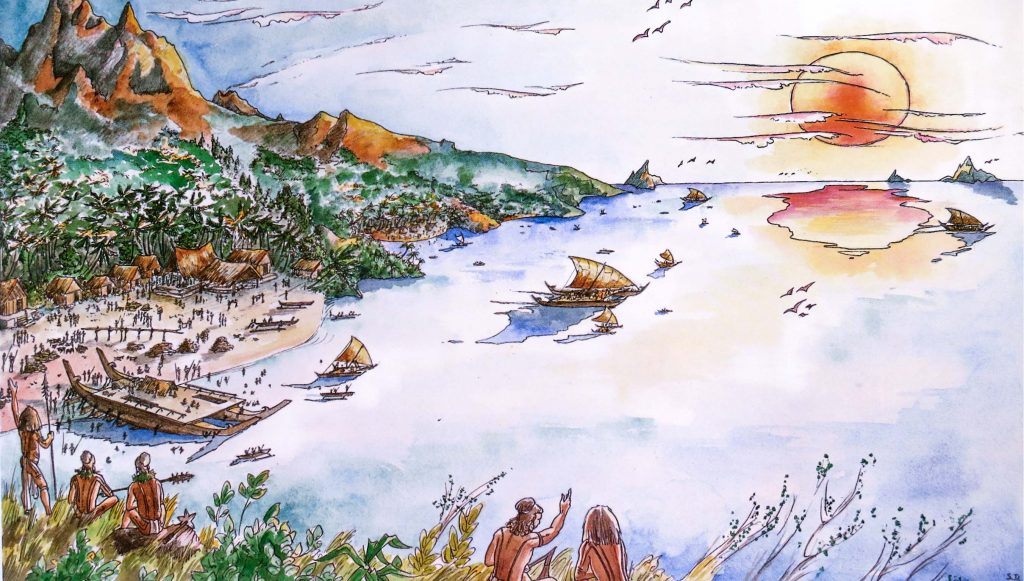[et_pb_section fb_built=”1″ _builder_version=”4.0.2″ background_image=”https://moevarua.com/wp-content/uploads/2019/10/3c67f9c7-68c0-4a30-8208-029d41259e3c.jpg” custom_padding=”100px||1480px|||”][et_pb_row _builder_version=”4.0.2″][et_pb_column type=”4_4″ _builder_version=”4.0.2″][et_pb_text _builder_version=”4.0.2″ header_text_align=”center” header_text_color=”#ffffff” header_font_size=”55px” header_text_shadow_style=”preset2″]
Sex and Divinity in Polynesia
[/et_pb_text][/et_pb_column][/et_pb_row][/et_pb_section][et_pb_section fb_built=”1″ _builder_version=”4.0.2″ custom_padding=”||27px|||”][et_pb_row column_structure=”1_2,1_2″ _builder_version=”4.0.2″][et_pb_column type=”1_2″ _builder_version=”4.0.2″][et_pb_text _builder_version=”4.0.2″ text_text_color=”#000000″ text_font_size=”16px”]The real understanding of Polynesian culture has been very slow. Stories, drawings and even photographs of explorers, navigators, missionaries and other visitors of the eighteenth and nineteenth centuries have been assumed as real and objective and have rarely been questioned. The natives were represented according to a stereotype, usually dressed in native costumes and certain ornaments that demonstrated their exoticism. Women were described as “a naked Venus before the Phrygians”, an opinion issued by Bouganville regarding women in Tahiti, which served to underline the sexual availability and promiscuity of Polynesian women.[/et_pb_text][/et_pb_column][et_pb_column type=”1_2″ _builder_version=”4.0.2″][et_pb_code _builder_version=”4.0.2″][bsa_pro_ad_space id=3][/et_pb_code][/et_pb_column][/et_pb_row][et_pb_row _builder_version=”4.0.2″][et_pb_column type=”4_4″ _builder_version=”4.0.2″][et_pb_text _builder_version=”4.0.2″ text_text_color=”#000000″ text_font_size=”16px”]The objectives of the first European visitors of Rapa Nui, without a doubt may have been, not only the supply of the ships, but also the sexual trafficking with the native women. We often read that women were attractive and friendly and volunteered to sailors (Arredondo 2000). However, a careful reading of the chronicles of the Dutch (1722), of the Spanish expedition in 1770, of Cook and the naturalists Johann and George Forster in 1774, allow these claims to be questioned.
Roggeven in 1772 emphasizes that only two or three old women approached the ship, and that no young woman or girl did. Captain Behrens, of the same expedition, indicates that old women dressed in red and white cloths sat in front of them and undressed, that they were cheerful and friendly. He also relates that others signaled them to invite them to approach the houses. Agüera e Infanzón (Mellén Blanco, 1986), officer of the ship “Santa Rosalía”, reports that “they insistently demonstrated what each one could offer a man.” In his opinion they seemed to be the old women, the old midwives, the ones who They always accompany and offer young women. Cook in 1774 observes few women and that they were held inside the houses and in the care of an older man. Surely these observations were influenced by the wishes and fears of Europeans and written with a Western and non-Polynesian lens. The importance of the reproduction of life, of fecundity and sexual symbolism in ancestral Polynesian societies was clear, and its manifestation explicit. These were societies in which relationships were constantly being created from practice; especially sexual practice.[/et_pb_text][/et_pb_column][/et_pb_row][/et_pb_section][et_pb_section fb_built=”1″ fullwidth=”on” _builder_version=”4.0.2″][et_pb_fullwidth_image src=”https://moevarua.com/wp-content/uploads/2019/10/84ac28f9-1c52-4a7a-ba70-9068487f7dfa.jpg” _builder_version=”4.0.2″][/et_pb_fullwidth_image][/et_pb_section][et_pb_section fb_built=”1″ _builder_version=”4.0.2″ custom_padding=”||27px|||”][et_pb_row column_structure=”1_2,1_2″ _builder_version=”4.0.2″][et_pb_column type=”1_2″ _builder_version=”4.0.2″][et_pb_text _builder_version=”4.0.2″ text_text_color=”#000000″ text_font_size=”16px”]Polynesian ethnographic records indicate that spirits or deities are physically related to humans, especially through sexual intercourse. The importance of the sexual act was key, being the very representation of the regeneration of nature. The physical and sexual bond is positioned as an act linked to the sacred, where the divine and the earthly united to create life. Sex is the way to perpetuate life, both for the gods and for people and many times between them. A common practice was the forced presentation of virgin girls who were to marry a high chief. In ritual dances, the front row was reserved for young virgins. What was the special importance of virginity in all these cases? It has to do with the first child. The first son belonged to the community. The first child born to a high-ranking woman in Tahiti is known as “matahiapo”, which means born from under the bark cloth (mahute). The mahute like the feathers are the clothing of the gods, and even a “way” for the gods to come down to earth. Also the sacred objects used to be wrapped in mahute.[/et_pb_text][/et_pb_column][et_pb_column type=”1_2″ _builder_version=”4.0.2″][et_pb_code _builder_version=”4.0.2″][bsa_pro_ad_space id=2][/et_pb_code][/et_pb_column][/et_pb_row][et_pb_row _builder_version=”4.0.2″][et_pb_column type=”4_4″ _builder_version=”4.0.2″][et_pb_text _builder_version=”4.0.2″ text_text_color=”#000000″ text_font_size=”16px”]Throughout Polynesia, the idea and practice of theogamy is sustained, in which physically a girl, without necessarily having reached puberty, is presented in marriage to foreigners arriving from the horizon – the place of ancestors and symbolic residence of the divinities. Cook in Hawaii describes that: “at the precise moment that I jumped ashore, everyone fell on their faces and remained in this position of compliance until I signaled them to get up.” The fact of having arrived from the horizon and from The sunset direction associates foreigners with the Po, the primordial darkness. The white color is the color of the sun and these white men, powerful in their ships with white sails, capable of emitting fire and thunder noises like the gods, were received as the personification of the divinities, were symbols of the divine. Consequently the Polynesians wanted to relate to them through the generative powers they shared. From this point of view, Polynesian cosmology demands the presence of a female being who had not yet given birth, to create a child with divine properties.[/et_pb_text][/et_pb_column][/et_pb_row][/et_pb_section][et_pb_section fb_built=”1″ fullwidth=”on” _builder_version=”4.0.2″][et_pb_fullwidth_image src=”https://moevarua.com/wp-content/uploads/2019/10/9560e62b-c8ea-4f1a-80ae-146257c86fc2.jpg” _builder_version=”4.0.2″][/et_pb_fullwidth_image][/et_pb_section][et_pb_section fb_built=”1″ _builder_version=”3.22.7″ custom_padding=”0px||0px|||”][et_pb_row _builder_version=”3.25″ width_tablet=”” width_phone=”” width_last_edited=”on|phone” custom_padding=”||0px|||”][et_pb_column type=”4_4″ _builder_version=”3.25″ custom_padding=”|||” custom_padding__hover=”|||”][et_pb_text _builder_version=”3.27.4″ custom_padding=”||0px|||”][bsa_pro_ad_space id=1][/et_pb_text][/et_pb_column][/et_pb_row][/et_pb_section][et_pb_section fb_built=”1″ _builder_version=”3.22.7″ custom_padding=”3px||0px|||”][et_pb_row _builder_version=”3.25″][et_pb_column type=”4_4″ _builder_version=”3.25″ custom_padding=”|||” custom_padding__hover=”|||”][et_pb_text _builder_version=”3.27.4″]
Featured Reports:
[/et_pb_text][et_pb_blog fullwidth=”off” posts_number=”3″ include_categories=”4″ show_date=”off” use_overlay=”on” _builder_version=”4.0.2″][/et_pb_blog][/et_pb_column][/et_pb_row][/et_pb_section]

















